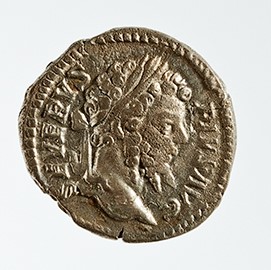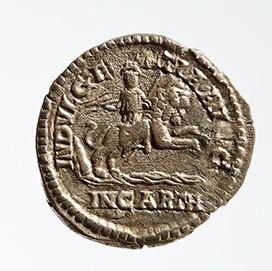Acquisition number: 2007.04
Obv.: Bust of Septimius Severus, laureate, r. SEVERVS PIVS AVG(ustus).
Rev.: Figure of Dea Caelestis (‘heavenly goddess’), holding thunderbolt in right hand and sceptre in left; seated facing, head r., on lion leaping to r., over water gushing from rock. She sets her right hand on a drum balanced on lion. INDVLGENTIA AVGG (= Augustorum) round edge; IN CARTH(aginem) in exergue.
Title: Denarius of Septimius Severus - 2007.04
Acquisition number: 2007.04
Author or editor: Beryl Rawson
Culture or period: Roman Imperial
Date: AD 203-204
Material: Metal - Silver
Object type: Coins - Roman
Dimensions: 18mm (w)
Origin region or location: Italy
Origin city: Rome
Display case or on loan: 7
Keywords: Coin, denarius, Roman, Imperial, Septimius Severus, Dea Caelestis
Sear, D.R., Roman Coins and their Values 5 vols (London, Spink, 2000-2014) 6285; Seaby, H.A., Roman Silver Coins (London, B.A. Seaby, 1967) III 222; Mattingly, H.,Coins of the Roman Empire in the British Museum, 6 vols (London, 1965) 335-8.
2007.04
Denarius of Septimius Severus
2.47 g. AD 203-204
Obv.: Bust of Septimius Severus, laureate, r. SEVERVS PIVS AVG(ustus).
Rev.: Figure of Dea Caelestis (‘heavenly goddess’), holding thunderbolt in right hand and sceptre in left; seated facing, head r., on lion leaping to r., over water gushing from rock. She sets her right hand on a drum balanced on lion. INDVLGENTIA AVGG (= Augustorum) round edge; IN CARTH(aginem) in exergue.
Septimius Severus took the name Pius to connect himself with the Antonine dynasty. Cf. on 1966.53. The form of the name on the obverse belongs to the period AD 201-210. The specific date for this coin may be AD 204, when Septimius celebrated the Secular Games and gave a special role to the deities of his native North Africa. His birthplace was Leptis Magna, but the beneficence (indulgentia) recorded here (a new aqueduct? improved water supply?) is to Carthage, of which Dea Caelestis was a goddess.
Minted in Rome, but using symbolism from Africa, Septimius’ native province. Dea Caelestis was the principal deity of Carthage. Her representation with a lion and wild countryside is reminiscent of Cybele, whose worship had been introduced at Rome from the East and had spread to Gaul and Africa. Apuleius, a second century writer himself from Africa, has Psyche call on Juno in this guise, worshipped in Carthage as a virgin goddess drawn across the heavens by a lion. (Metamorphoses 6.4: ‘…celsae Carthaginis, quae te uirginem uectura leonis caelo commeantem percolit, …’) The thunderbolt marks the character of the goddess as a sky goddess (Caelestis).
The reverse legend, ‘Generosity of the emperors [Septimius and Caracalla]’, indicates some special favour to Carthage, perhaps connected with the water supply (a new aqueduct?).
Cf. 1966.51
Sear, D.R., Roman Coins and their Values 5 vols (London, Spink, 2000-2014) 6285; Seaby, H.A., Roman Silver Coins (London, B.A. Seaby, 1967) III 222; Mattingly, H.,Coins of the Roman Empire in the British Museum, 6 vols (London, 1965) 335-8.

